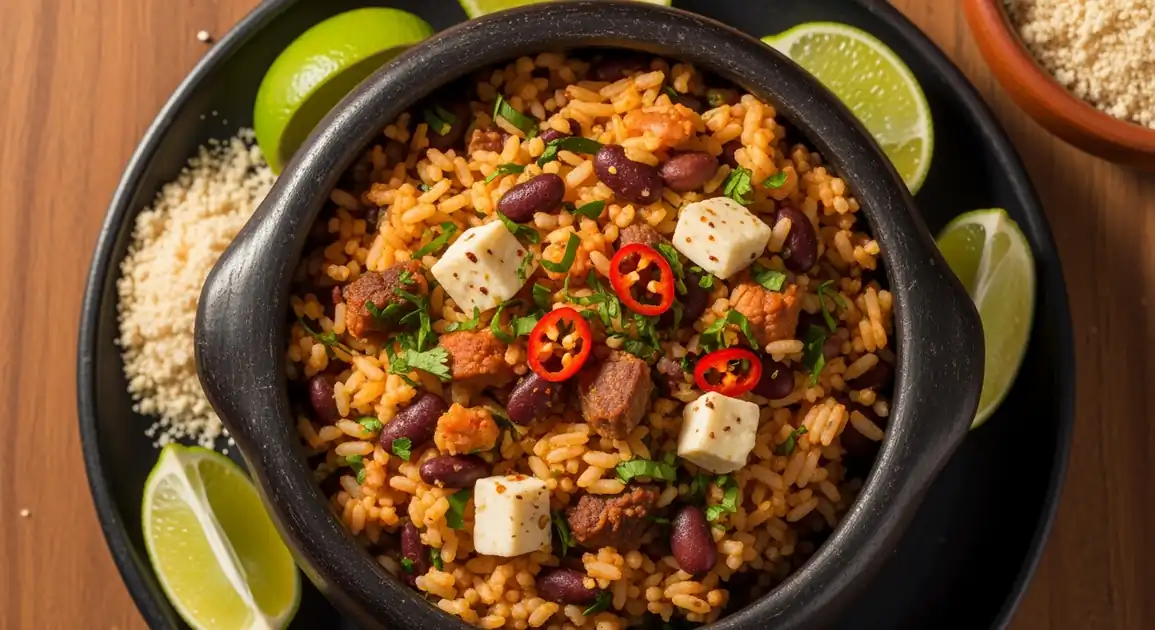Baião de Dois
Baião de Dois

Description
Baião de Dois originated in Brazil's Northeast region but has become beloved nationwide as comfort food representing regional diversity. While variations exist throughout the country, the dish maintains its essence of combining rice and beans in one flavorful pot, often accompanied by local cheeses and meats appropriate to each region.
Dietary Information
Serving information
Serving style
Traditionally served in a clay pot or cast iron pan to maintain heat, accompanied by farofa (toasted cassava flour), vinaigrette, and sometimes collard greens.
Quick facts
Most widely available during lunch (11 AM - 3 PM) and dinner (6 PM - 10 PM) hours at restaurants. Cultural centers and weekend markets may serve it continuously.
Safety Tips
What to Look For
-
Freshly prepared dish served steaming hot
Properly heated food minimizes bacterial risk. The dish should be served steaming and the cheese should be fully melted.
-
Clean restaurant or food stall with proper refrigeration
Since Baião de Dois contains perishable ingredients like cheese and sometimes meat, proper storage is essential.
-
Visible, identifiable ingredients
You should be able to distinguish individual rice grains, beans, and pieces of cheese or meat. Avoid versions where everything is mushed together.
-
Herbs that look fresh and green
Wilted or discolored herbs may indicate the dish was prepared long ago or stored improperly.
What to avoid
-
Refrigerated and reheated versions
Rice dishes can develop bacteria when improperly stored and reheated. Prefer freshly made Baião de Dois.
-
Excessively dry or crusty appearance
This suggests the dish has been sitting under heat lamps or warming equipment for too long.
-
Sour smell or off taste
Can indicate spoilage of dairy or meat components. Trust your senses.
-
Room temperature serving
The dish should be served hot, not lukewarm, especially because of the cheese and potential meat content.
Price information
Price range
Budget tips
- Lunch specials ("pratos executivos") often offer better value than dinner menu prices.
- Northeastern-themed buffets ("rodízio nordestino") sometimes include unlimited Baião de Dois with other regional dishes.
- Family-style portions are often available and more economical when sharing.
Value indicators
- Generous portion size with visible chunks of cheese and meat (if included).
- Served with traditional sides like farofa, vinaigrette, and sliced chili peppers.
- Fresh herbs visibly incorporated rather than just as garnish.
- Authentic clay pot or cast iron serving vessel.
Where to Find This Dish
Northeastern Cultural Centers
Venues celebrating northeastern culture typically serve authentic versions.
Feira de São Cristóvão (Northeastern Fair)
Weekend Afternoons, Friday and Saturday Evenings
Traditional Markets
Food courts in municipal markets often feature regional Brazilian cuisine.
Municipal markets, Covered food halls
Midday (11 AM - 2 PM)
Working-class Neighborhoods
Family-run restaurants in areas with northeastern immigrant populations.
Small restaurants with "Comida Nordestina" signs
Lunch (11 AM - 2 PM)
Vendor Tips
- Restaurants displaying the flags or symbols of northeastern states (Ceará, Pernambuco, etc.) often serve more authentic versions.
- Places with "Baião" in their name usually specialize in northeastern cuisine and likely make better versions.
- If they make their own queijo coalho in-house or source it from northeastern producers, quality is likely higher.
How to Order
Regional Variations
-
Baião de Dois with Carne de Sol
(Baião de Dois com Carne de Sol)
The classic version featuring sun-dried beef, providing a rich, concentrated meat flavor.
-
Vegetarian Baião de Dois
(Baião de Dois Vegetariano)
Omits meat while retaining the cheese, perfect for vegetarians seeking the traditional flavor profile.
-
Seafood Baião de Dois
(Baião de Dois com Frutos do Mar)
A coastal adaptation featuring shrimp or other seafood instead of carne de sol, popular in Rio's seafood restaurants.
-
Green Baião de Dois
(Baião de Dois Verde)
Made specifically with green beans (feijão verde) for a more distinctive color and slightly different flavor profile.
-
Vegan Baião de Dois
(Baião de Dois Vegano)
Modern adaptation replacing cheese with nutritional yeast or plant-based alternatives and using vegetable oil instead of butter.
Cultural context
History
Baião de Dois originated in Brazil's Northeast, particularly in Ceará and Pernambuco states, as a practical solution to limited resources among working-class families. Its name refers to "baião," a popular northeastern music rhythm, suggesting the harmonious "dance" of rice and beans cooking together. Historically, it was a way to transform basic staples into a complete protein-rich meal, using ingredients available to rural communities. The dish gained national popularity as northeastern migrants brought their culinary traditions to major cities like Rio de Janeiro, where it's now celebrated as comfort food and a symbol of regional Brazilian heritage.
Local significance
Represents northeastern culinary ingenuity and the Brazilian talent for creating satisfying meals from simple ingredients. Symbolizes the cultural contributions of northeastern migrants to Brazil's national identity.
Eating customs
- Typically eaten with a fork rather than mixed with other items.
- Often consumed with a side of hot sauce (pimenta) that diners add to taste.
- Commonly paired with cold beer or fresh fruit juices.